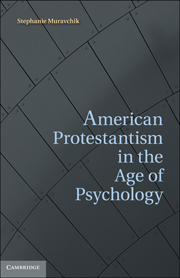Book contents
- Frontmatter
- Contents
- Acknowledgments
- Abbreviations
- 1 The Fall and Rise of Psychoreligious Cooperation
- PART ONE THERAPY AS MINISTRY IN CLINICAL PASTORAL EDUCATION
- PART TWO THERAPY AS FELLOWSHIP IN ALCOHOLICS ANONYMOUS
- PART THREE THERAPY AS EVANGELISM IN THE SALVATION ARMY
- 6 Freud Is Not a Suitable Psychologist
- 7 New Creatures in Christ
- 8 Conclusion: American Psychology in an Age of Faiths
- Bibliography
- Index
8 - Conclusion: American Psychology in an Age of Faiths
from PART THREE - THERAPY AS EVANGELISM IN THE SALVATION ARMY
Published online by Cambridge University Press: 05 July 2011
- Frontmatter
- Contents
- Acknowledgments
- Abbreviations
- 1 The Fall and Rise of Psychoreligious Cooperation
- PART ONE THERAPY AS MINISTRY IN CLINICAL PASTORAL EDUCATION
- PART TWO THERAPY AS FELLOWSHIP IN ALCOHOLICS ANONYMOUS
- PART THREE THERAPY AS EVANGELISM IN THE SALVATION ARMY
- 6 Freud Is Not a Suitable Psychologist
- 7 New Creatures in Christ
- 8 Conclusion: American Psychology in an Age of Faiths
- Bibliography
- Index
Summary
One aspect of the much-lamented “spread of a therapeutic ethos” was the extensive adoption of psychotherapeutic ideas and techniques by American religious groups after World War II. They pursued religious goals by forging convergences between spiritual and psychological systems. This was a difficult and contentious effort. Groups were always haunted by the possibility that they would sell a precious birthright of fellowship and holy wisdom for a potage of self-love and secular casuistry. And, in fact, believers overwhelmed by urgent earthly hungers occasionally made the trade off, as we saw among ministers who felt there was little nourishment left in traditional treatments of the Gospel. Yet they were a small minority compared with the larger groups of clergy and lay persons from across the American Protestant spectrum whose efforts were spiritually successful.
These men and women raided the cupboards of psychology for ways to strengthen and democratize their ministries, their evangelism, and their fellowships. Their efforts led to the opposite of the disenchantment and solipsistic individualism that has often been warned against. Instead, they fostered a sense of transcendence and even faith in God. They connected people socially. And they even inspired ethical striving. This was possible because believers recast psychotherapy in their own image. They relied in part on spiritually oriented paraprofessionals and lay persons to deliver therapy. And they expanded the definition of what constituted therapy to include religious traditions and spiritual activities.
- Type
- Chapter
- Information
- American Protestantism in the Age of Psychology , pp. 215 - 222Publisher: Cambridge University PressPrint publication year: 2011



